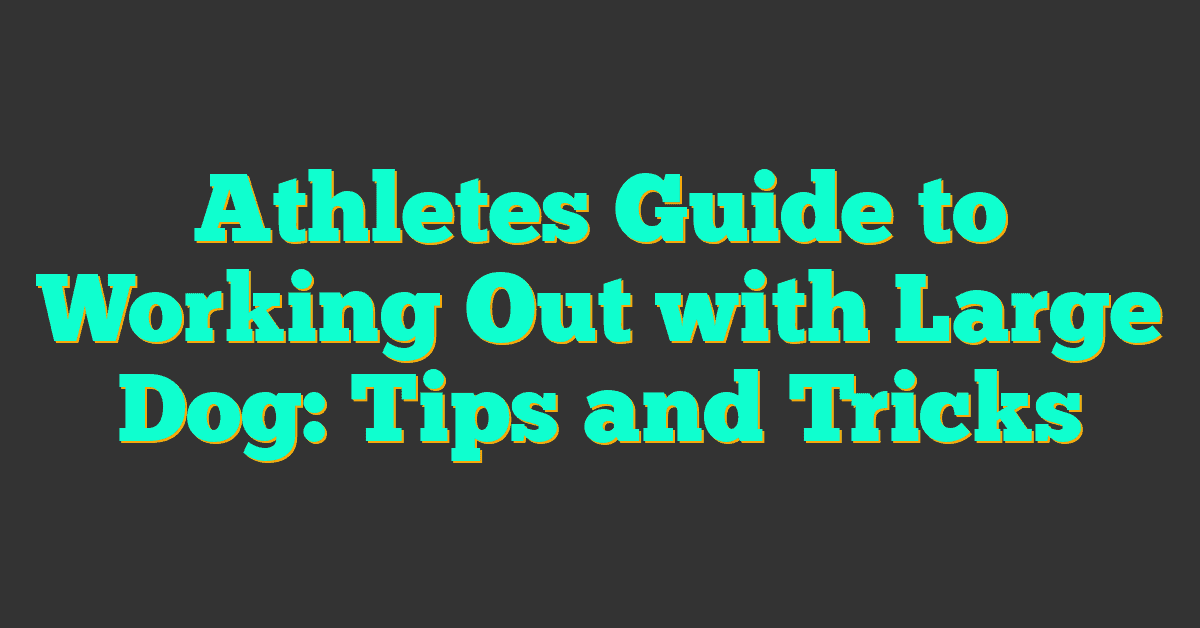If you’re an athlete who is also a dog owner, you might be wondering how to incorporate your furry companion into your workouts. Fortunately, working out with your large dog can be a fun and effective way to stay active and bond with your pet at the same time. However, it’s important to take certain precautions and tailor your workouts to your dog’s needs to ensure a safe and enjoyable experience for both of you.

Before you start working out with your dog, it’s important to prepare properly. This includes making sure your dog is healthy enough for exercise, investing in the right gear, and understanding your dog’s needs and limitations. By taking the time to prepare, you can help prevent injuries and ensure that your workouts are effective and enjoyable for both you and your dog.
When it comes to tailoring your workout routine to your dog, there are a few things to keep in mind. For example, you may need to adjust the intensity and duration of your workouts based on your dog’s age, size, and fitness level. Additionally, you’ll want to choose activities that are safe and enjoyable for both you and your dog. By taking these factors into account, you can create a workout routine that is both effective and fun for you and your furry friend.
Key Takeaways
- Proper preparation is key when working out with your large dog.
- Tailor your workout routine to your dog’s needs and limitations.
- Choose safe and enjoyable activities for both you and your dog.
Preparing for Workouts with Your Dog
https://www.youtube.com/watch?v=UMPi_Osunu8&embed=true

Working out with your dog can be an enjoyable experience for both you and your furry friend. However, before you start any physical activity, it’s important to prepare properly. Here are some things to keep in mind:
Understanding Your Dog’s Breed and Capabilities
Different dog breeds have different exercise requirements and capabilities. For example, a Greyhound may need more intense exercise than a Bulldog due to their genetics and energy levels. It’s important to research your dog’s breed and understand their exercise needs before starting any workout routine.
Health Check: Consulting a Veterinarian
Before starting any workout routine with your dog, it’s important to consult with a veterinarian. A vet can help determine if your dog is healthy enough to participate in physical activity and can also provide advice on how to keep your dog safe during exercise.
Creating a Safe Environment
Creating a safe environment is crucial for working out with your dog. Make sure your workout area is free of any hazards that could cause injury to your dog. Additionally, it’s important to use proper equipment, such as a sturdy leash and collar, to keep your dog secure during exercise.
In summary, preparing for workouts with your dog involves understanding your dog’s breed and capabilities, consulting with a veterinarian, and creating a safe environment. By taking these steps, you can ensure a safe and enjoyable workout experience for both you and your furry friend.
Tailoring Your Workout Routine
https://www.youtube.com/watch?v=LGdhcU0eNzQ&embed=true
When working out with your large dog, it is important to tailor your exercise routine to both you and your dog’s needs. This means designing a balanced exercise schedule that incorporates rest and recovery.
Designing a Balanced Exercise Schedule
As an athlete, you understand the importance of a balanced exercise schedule. The same goes for your dog. It is important to incorporate a variety of exercises that focus on stamina, endurance, and strength. This can include activities such as running, hiking, and playing fetch.
When designing your exercise schedule, consider factors such as your dog’s age, breed, and overall health. For example, older dogs may require more rest and recovery time between workouts, while high-energy breeds may require more intense exercise sessions.
To ensure that you and your dog are getting the most out of your workouts, consider incorporating interval training into your routine. This can help improve your dog’s cardiovascular health and endurance, while also helping to build strength and stamina.
Incorporating Rest and Recovery
Rest and recovery are just as important as exercise when it comes to maintaining a healthy workout routine. When working out with your dog, it is important to give your pet adequate rest and recovery time between workouts.
This can include incorporating rest days into your exercise schedule, as well as providing your dog with plenty of water and a healthy diet. Additionally, consider incorporating activities such as stretching and massage into your routine to help your dog recover faster and prevent injury.
By tailoring your workout routine to your and your dog’s needs, you can ensure that you are both getting the most out of your exercise sessions. Remember to always listen to your dog’s cues and adjust your routine as needed to ensure that your pet is comfortable and healthy.
Training Techniques and Commands
https://www.youtube.com/watch?v=XQRgci18tvY&embed=true
When working out with your large dog, training techniques and commands are crucial to ensure safety and efficiency. Here are some effective communication and behavior management techniques to keep in mind:
Effective Communication and Gesture
Using clear and consistent gestures and commands can help your dog understand what you want them to do. Positive reinforcement, such as treats and praise, can also help motivate your dog to follow your commands. For example, when teaching your dog to sit, use a hand gesture and say “sit” in a clear and firm tone. When your dog sits, reward them with a treat and praise. Repeat this process until your dog learns the command.
Behavior Management During Workouts
During workouts, it’s important to manage your dog’s behavior to prevent rough play or biting. Use a leash to control your dog’s movements and keep them focused on the workout. If your dog becomes too excited or starts to play rough, take a break and redirect their attention to a toy or treat.
It’s also important to be aware of your dog’s body language and behavior. If your dog seems uncomfortable or hesitant, take a step back and adjust your training techniques. A professional trainer can also help you develop effective training techniques and behavior management strategies.
« Sam Laidlow: Athlete Breakdown
Average Olympic Triathlon Time: What You Need to Know »
By using effective communication and behavior management techniques, you can train your large dog to be a great workout partner. With patience and consistency, your dog can become a valuable asset to your fitness routine.
Exercise Activities for You and Your Dog
https://www.youtube.com/watch?v=Yqgbqay6bAY&embed=true
Working out with your dog can be a fun and engaging way to stay active and bond with your furry friend. Here are some exercise activities that you and your large dog can enjoy together:
Running and Sprinting Drills
Running is a great way to get your heart rate up and burn calories. You can incorporate your dog into your running routine by taking them on a leash or letting them run alongside you in a safe and enclosed area. You can also try sprinting drills, such as 30-second sprints followed by 30-second walks, to increase your endurance and speed.
Agility and Strength Training
Agility and strength training exercises can help improve your dog’s physical abilities and overall health. You can set up an obstacle course in your backyard or local park using items such as cones, hurdles, and tunnels. You can also incorporate strength training exercises, such as lunges and squats, while holding onto your dog’s leash for added resistance.
Fun and Engaging Playtime
Playing with your dog is not only fun, but it can also provide a great workout for both you and your furry friend. You can play fetch with a ball or frisbee, or try tug-of-war with a rope toy. You can also try incorporating physical activity into playtime by playing hide-and-seek or running around together in a safe and enclosed area.
Remember to always prioritize safety when exercising with your dog. Make sure to provide plenty of water and breaks, and consult with your veterinarian before starting any new exercise routine. By incorporating your dog into your workout routine, you can stay active while strengthening your bond with your furry friend.
Nutrition and Health for Athletic Dogs
https://www.youtube.com/watch?v=gAEJG93cR3g&embed=true
As an athlete, your large dog requires a balanced diet to maintain good health and performance. Proper nutrition is essential for your dog’s immune system, weight management, and body composition. In this section, we will discuss the two most important aspects of nutrition and health for athletic dogs: balanced diet and understanding canine health issues.
Balanced Diet for Active Canines
A balanced diet for active dogs should contain high-quality proteins, moderate fat, and low carbohydrates. Proteins are essential for muscle growth and repair, while fat provides energy for exercise and helps maintain healthy skin and coat. Carbohydrates are also important for energy but should be limited to prevent weight gain.
When choosing food for your athletic dog, look for brands that contain high-quality proteins such as chicken, beef, fish, or lamb. Avoid foods that contain fillers, artificial preservatives, or by-products. You can also supplement your dog’s diet with fresh vegetables and fruits, which provide essential vitamins and minerals.
It’s also essential to provide your dog with plenty of fresh, clean water. Dehydration can lead to serious health issues, including heatstroke, which is common in athletic dogs.
Understanding Canine Health Issues
Athletic dogs are prone to certain health issues, including joint problems, hip dysplasia, and obesity. Regular exercise and proper nutrition can help prevent these issues, but it’s also important to monitor your dog’s health and seek veterinary care when necessary.
As an athlete, your dog may be more prone to injuries, so it’s essential to warm up before exercise and cool down afterward. You can also supplement your dog’s diet with joint supplements such as glucosamine and chondroitin, which can help prevent joint problems.
In conclusion, a balanced diet and understanding of canine health issues are essential for the health and performance of your athletic dog. By providing your dog with proper nutrition and monitoring their health, you can help prevent health issues and ensure that your dog is healthy and happy.
Frequently Asked Questions
https://www.youtube.com/watch?v=pJher8Wad8I&embed=true
What are some effective endurance training exercises for large dogs?
Endurance training exercises are great for large dogs that have high energy levels. Some effective exercises include jogging, running, swimming, and hiking. These exercises can help improve your dog’s cardiovascular health, build endurance, and burn off excess energy.
Can you recommend any conditioning equipment suitable for larger dog breeds?
There are many conditioning equipment options available for larger dog breeds. Some popular options include treadmills, agility equipment, and resistance bands. When selecting equipment, it’s important to consider your dog’s size, weight, and fitness level. Always consult with your veterinarian before starting any new exercise routine.
How can I safely incorporate my large dog into my workout routine?
Incorporating your large dog into your workout routine can be a fun and rewarding experience for both you and your pet. However, it’s important to start slow and gradually increase the intensity and duration of your workouts. Always warm up before exercising and cool down afterward. Be sure to provide plenty of water and rest breaks for your dog during workouts.
What are the best cardio exercises to do with a big dog?
Cardio exercises are great for improving your dog’s cardiovascular health and endurance. Some of the best cardio exercises to do with a big dog include running, jogging, swimming, and playing fetch. These exercises can help keep your dog healthy and active.
How much daily exercise is recommended for high-energy large dog breeds?
High-energy large dog breeds require a lot of exercise to stay healthy and happy. Most high-energy breeds require at least 30-60 minutes of exercise per day, but some may require more. It’s important to consult with your veterinarian to determine the appropriate amount of exercise for your dog based on their age, weight, and overall health.
Are there specific aerobics or activities that can help condition my large dog?
There are many aerobics and activities that can help condition your large dog. Some effective options include agility training, swimming, hiking, and running. These activities can help improve your dog’s endurance, strength, and overall fitness level.










